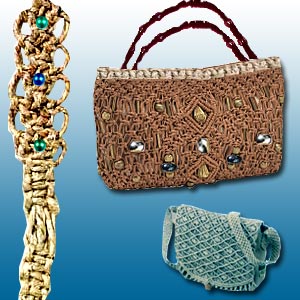How to Macrame

Macrame is an ancient craft of knotting in geometric patterns to create a host of creative arts; from jewelry and home decorations to plant holders and wall hangers. The term macrame is Arabic in origin meaning 'fringe'. The art of macrame dates back to the thirteenth century when the Arabian weavers started knotting the extra fabric at the edges of loomed fabric. What began as a craft making skillful use of knots has grown to become
History of macrame
The history of macrame can be traced to the early fourteenth and fifteenth centuries when this craft was practiced in France and Italy. The patterned knotted fabrics created out of macrame craft were used in churches for vestments and altar cloths in early days. This craft became popular among the British during the nineteenth century.
Legend goes that North American sailors spent long hours aboard ships practicing macrame square knots and hitch knots. These sailors made fringes for wheels and bell covers, netting and screens. Over the years this art and craft fell to disuse. It was again revived in the sixties with the 'hippie movement', which brought with it a revival of interest in this ancient craft. Today macrame craft has regained its immense popularity.
What is Macrame?
Macrame is an art of decorative knotting without using needles or hooks. By using a series of knots, many ornamental patterns are created. Macrame can be created using any kind of material. You can use fine thread to make macrame lace or even use leather strips. By a special technique, the macrame craft keeps the knots in place while the work is being done. Macrame can be tried by anyone with a passion to create with little or no experience. Even a small child can try macrame.
At the same time, macrame can pose a challenge and make it a most demanding craft for many senior artisans and craftsman. Creation of a decorative piece using the macrame craft requires artistic skill coupled with patience. It may even take many a month to finish a complex piece using high quality macrame work with intricate design.
Macrame materials
Vary the type of cord used and you can come up with elegant and artistic items. For instance the cord, which is dyed, cheap and excellent material for holding plant holders, is different from the embroidery threads that are used for delicate ornamental work.
Cotton crochet: This is a simple cord type, which is soft and easy to work with. It is available in myriad colors. This works well for small and delicate work.
Embroidery floss: This makes uses of strong cords in a variety of colors. The knots using this cord type are strong and difficult to untie.
Hemp: This is a strong natural fabric and wears well.
Polypropylene: This is a type of cord available in various sizes. It is strong and durable.
Rattail: This type of cord lends a satin feel to the crafted object. It is available in a variety of colors and sizes.
Soutache: This is a kind of flat-ribbed satin cord often using for trimming.
Waxed linen: This is best-suited for creating crisp knots. It is slightly stiff and can hold well.
Wire: This is used in macrame jewelry. Copper is the best choice as it provides strong and durable cord.
Calculating how much cording to use when making macrame items is very important. The length of cording should be calculated first. The recommended measurements have to be looked into before starting any macrame project. It is better to make sure that the ends are generously measured to avoid the risk of running out of cording during the course of the project. It would be much better to have extra cording than face the difficulty of adding a cord in an inconvenient place in the design.
Macrame knots
Many knots used in macrame craft can be traced back to sailors who entertained themselves with extra rope during long months at the sea.
- A half knot is used is tying the shoelace.
- A square knot is 'two half knots in opposite direction'.
- A double half hitch has one string bearing the knot while the other string wraps around it.
- An overhand knot is created with just one string where you make a loop knot onto itself.
Once these basic types of knots are mastered, one can personally investigate more complicated knots or just makeup ones' own knots. In professional macrame, the primary knots are the square knot and the forms of hitching - full hitch and double hitch. The other common knots used in macrame are overhand and double half hitch knots.
Larks' head knots: This is to tie the yarn mounted to its anchor or starting cord.
Double half hitch knots and Flat knot: These are the two basic knots in macrame work. Many of the macrame designs are built from the various combinations of these two knots.
Diagonal double half hitch knot: This is used to work the cord from the opposite direction. A firmly pinned mounting strand is essential to work this knot.
In Chinese macrame, some decorative knots are known by queer names such as 'Monkey's Fist', 'Double Coin' and 'Good Luck'.
It is essential for the knots to be in place for the yarn to be smooth, firm and thereby prevent stretching. It should knot easily yet hold the knot without slipping. For this purpose, an anchor, usually called a mount is used. This board or a spongy pad must be firm yet soft enough to hold pins. The macrame board will help you keep the size of the knots even and the pattern of the design uniform. Sometimes, yarn is tied onto the back of dining chairs, door handles, rod or ring to anchor the yarn and to hold under tension.
Macrame products
Macrame is a wonderful and delightful craft employed to make several useful things from bags and hanging baskets to purely decorative objects like jewelry and wall hangings. Exquisite macrame patterns are used in plant hangers, creative arts, clothing and much more. The ornamental knots of macrame can be even used in knife handles, bottle covers and tablecloth. Nowadays one can see macrame being used to cover lampshades, in a handbag or even a fine pair of shoes.
Macrame jewelry is often made in combination of various beads made of glass, wood, pendants or shells. Gemstones are also widely used in macrame rings. Wire is used in making necklaces. Leather and fabric is used to craft accessories like belts created using macrame techniques. Large macrame decorative pieces such as wall hanging or window coverings use wood and metal. Macrame wall hangings are made from a wide variety of material ranging from fine linen to heavy weight jute. Beads, feathers, buttons, rings and shells add a decorative touch to a fine piece of macrame work.
Macrame jewelry
Sterling silver, freshwater pearls, semi precious stones and Sworovski crystals are widely used to create stunning macrame jewelry. Macrame necklaces come in various designs and styles; the famous style being macrame Y-shaped necklaces. By varying the knots, their position and the kind of gemstone used, several one-of-a-kind designer necklaces are produced. Macrame chokers that come with semi precious stones and fresh water pearls are show stealers.
Macrame earrings and bracelets come in fiber and waxed linen and some in wire. Macrame earrings are light in weight and are of various sizes and shapes. Macrame anklets are also gaining in popularity among the westerners and Orientals these days. Macrame jewelry made of nylon waxed twine are light to wear in contrast to silver, gold and traditional jewelry with crystals and gemstones.
Macrame in textiles
Macrame is a form of textile-making using knots instead of weaving or knitting. It is similar to the crochet or Chinese knotting which is used to create intricate textiles. A variety of macrame called 'cavandoli macrame is used to form geometric patterns especially in weaving. Macrame craft is increasingly being used in clothing and textiles to cater to the refined and fashionable taste of customers.
Macrame classic lace art is used to make clothing more attractive. Studies reveal that in the nineteenth century, the craft of macrame, which is a specialty of Genoa, was used to decorate towels with knotted cords. Macrame can be used in making unique shawls and bedspreads. It is also used in draperies. This ancient decorative art lends an instant vintage and classic look.
Chinese Macrame
Chinese Macrame was used to decorate the palace halls and country households since ancient times. Chinese macrame has also appeared in paintings and other pieces of folk art. The royalty in China decorated their chairs, lady's dresses, mirrors, pouches, eyeglasses, fans and Buddhist rosaries with macrame. Chinese macrame is ornamental and of immense aesthetic value. Complicated Chinese macrame allows all kinds of variations that enhance its decorative value. These designs are visually enchanting and well appreciated by macrame lovers around the world.
Chinese macrame is based on a dozen basic knot types named according to their distinctive shapes, uses and origins. The knots in Chinese macrame are pulled very tightly. They cannot be easily undone. They are very practical. They come in exquisite symmetry. Chinese macrame, similar to the Chinese calligraphy, porcelain and painting is easily recognizable to admirers of Chinese culture.
Macrame hobby
Besides the many decorative items and useful products that macrame creates, there are other benefits derived from macrame. Macrame is therapeutic in nature. Pulling and working of the cords helps to strengthen the hands and arms. It helps to loosen the joints.
Some people find that macrame, an art of repetitive knots used to create designs is meditative bringing with it peace and calmness of mind. Some twine and a few basic knots are all a hobbyist needs to explore the immense possibilities that macrame offers. Macrame craft does not employ many supplies or tools. Macrame is making a comeback in a big way.
Top of the Page: How to Macrame
Tags:#macrame

Women Recreation Guide
Kitesurfing Gear
Wire Jewelry Making
Christmas Craft Project
Clay Pottery
Quilting Fabric
Importance of Hobby
Hobby Interest
Silk Painting
Doodling Interpretation
Calligraphy
Sudoku Tips
Coin Collecting
Scrapbooking Idea
Ikebana
Hobby and Craft
Valentine Day Crafts
Bead Craft
More on Hobby

How to Macrame
Origami Flower
Collectible Hobby
Stamp Collecting
Snorkeling
Hobby Photography
Thanksgiving Craft
Digital Photography Tip
Top of the Page: How to Macrame
Popularity Index: 102,211

